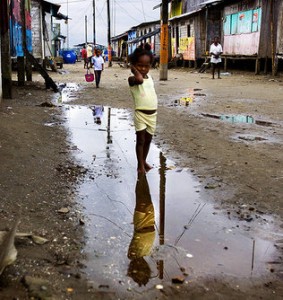October 21, 2010
An invisible long-running crisis
Colombia has suffered a 40-year long internal conflict, the longest in Latin American history and one of the longest running in the world. Throughout the four decades the characteristics of the crisis have remained the same: land dispossession, displacement and systematic violence against the civil population. The country has the second largest number of displaced persons, around 5 million or 8% of the population, after Sudan and serious issues around access and protection. However, the crisis has been invisible to, largely neglected or forgotten by major donors and international media. This is in part due to the overwhelming success of the government of Alvaro Uribe over the past eight years to very deliberately shift the discourse and focus away from the armed conflict and humanitarian situation to a more convenient security, anti-terrorism, anti-drug trade, development and trade agenda. The subsequent acceptance by most donor governments of this position, and their prioritization of trade, development and other issues, has contributed to keeping the humanitarian crisis invisible. This is despite evidence that the IDP situation is deteriorating and humanitarian needs are increasing as a result of the government’s policies.
“Donors should engage with new government on protection and humanitarian needs”
Key challenge: the government does not accept the existence of an armed conflict
 As highlighted in last year’s HRI Colombia report, the Government is moving forward with implementation of its “Plan de Consolidación” aimed at recovering territory from FARC and re-instituting state control and services and Presidential decree 001 which essentially restricts humanitarian access by “requiring” humanitarian actors to “coordinate” activities through the military and the state agency for IDP issues, “Acción Social”. Humanitarian actors in Colombia are very concerned about these measures, as they fear that they put the civilian population and humanitarian actors at risk of reprisals from armed groups, and compromise the neutrality and independence of humanitarian action. Yet despite the seriousness of the situation, there has been little coordinated action amongst humanitarian organizations, and even less so amongst donors, to advocate for safe humanitarian access and protection of civilians. This reflects the sense of fatigue and resignation amongst many of the actors interviewed that the situation will not change in the short term. However, the recent elections may open up new channels for dialogue, and opportunities for humanitarian actors to push for a more nuanced stance by the government.
As highlighted in last year’s HRI Colombia report, the Government is moving forward with implementation of its “Plan de Consolidación” aimed at recovering territory from FARC and re-instituting state control and services and Presidential decree 001 which essentially restricts humanitarian access by “requiring” humanitarian actors to “coordinate” activities through the military and the state agency for IDP issues, “Acción Social”. Humanitarian actors in Colombia are very concerned about these measures, as they fear that they put the civilian population and humanitarian actors at risk of reprisals from armed groups, and compromise the neutrality and independence of humanitarian action. Yet despite the seriousness of the situation, there has been little coordinated action amongst humanitarian organizations, and even less so amongst donors, to advocate for safe humanitarian access and protection of civilians. This reflects the sense of fatigue and resignation amongst many of the actors interviewed that the situation will not change in the short term. However, the recent elections may open up new channels for dialogue, and opportunities for humanitarian actors to push for a more nuanced stance by the government.
The response
Due to the government’s denial of armed conflict, there is no official appeal for Colombia. The Colombian government itself invests a significant amount of money through the state agency, “Acción Social”, to provide services to displaced populations, arguing that it is fulfilling its obligations to its citizens and has no need for international assistance. Nevertheless, there is a core group of donors, mainly ECHO, Norway, Germany, Sweden, Canada and the US, that consistently contribute to humanitarian action in Colombia. FTS reports suggest there was an increase in funding from US$41.4 million in 2008 to US$54.8 million in 2009. However, it is difficult to assess the full extent of donor funding to Colombia for the crisis, as some donors fund humanitarian-related activities through other mechanisms and funding envelopes (such as post-conflict and development programmes). Regardless, humanitarian action is hardly a priority for most government donors. By way of example, according to a review of US government documents, the US spent nearly US$ 400 million in 2009 for military and police assistance (including anti-drug activities) and some US$ 240 million in economic and social assistance. Only US$ 5.1 million of this was designated for humanitarian action.
Compared to other crises, funding for protection and coordination is relatively high in Colombia. But the funding has not translated into effective action. There was a lack of attention to conflict preparedness and prevention. Medium to long-term strategies to anticipate and prepare for changes in the nature of the conflict are also largely absent in the response. Some positive areas of the response included support for integrated programmes, good monitoring and engagement of some donors like ECHO with their partners, and donor understanding of the context – although this did not lead to a more coordinated response amongst donors to advocate with the government on issues of access and protection.
| The field mission Dates: 1-8 May 2010 Team: Eva Cervantes, Iñaki Martín, Ana Martiningui and Philip Tamminga (Team leader). |
Share this